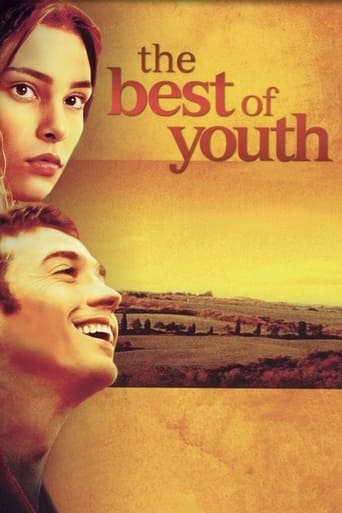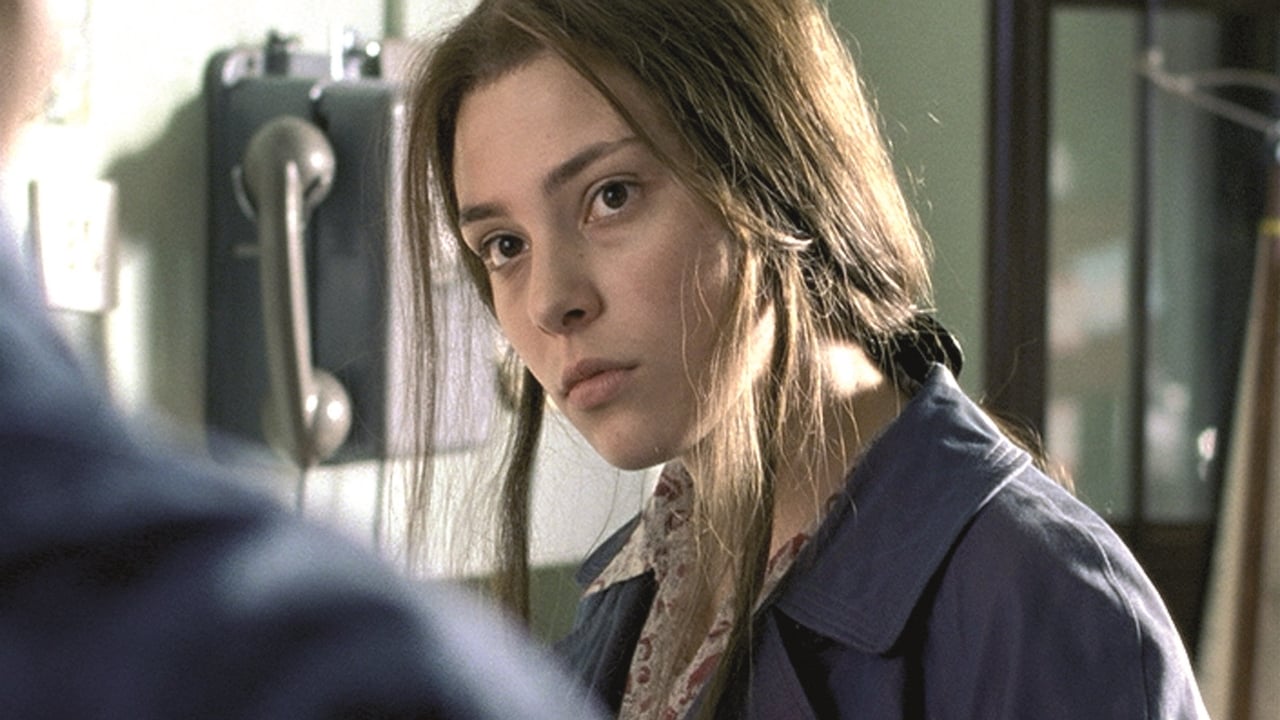CornellWatcher
It is difficult for me to write a review right now explaining why this is one of the best films I've ever seen while giving it the justice it has earned. The Best of Youth which was directed with perfection by Marco Tullio Giordana and stars Luigi Lo Cascio and Alessio Boni, is a grand epic that is unforgettable. Knowing little about the story and its characters I was unprepared by how the powerful soul of this beautiful film would affect me! The narrative begins in Italy with Nicola (Cascio) and Matteo Carati (Boni) who are brothers growing into adulthood during the 1960s when the country is undergoing major political change. It is a heartfelt tale that elevates itself into something more than a traditional family drama with Nicola and Matteo serving as our guides through the development of their country and family as the two progress into the 2000s.To start off, I loved the script for the film that was written by Sandro Petraglia and Stefano Rulli. Every scene, shot, and character flowed with a genuine humanity that I wish most films had. The Best of Youth is also a bildungsroman that is in tradition with Margaret Mitchell's "Gone with the Wind," that it chronicles the lives and experiences of the characters coming of age during an important political era. For example, in the beginning the brothers are separated for a time and are reunited once again in Florence during the dreadful 1966 Arno River Flood. These characters become apart of you as their story becomes your story. A viewer can look at the Carati family and immediately find a familiarity in their lives that we recognize in our own identities.As I said above, Giordana's direction is flawless as he invites us to feel the pleasures, nuances, and conflicts of the era he is depicting. With the extraordinary photography by Roberto Forza, Giordana captures the best parts of Italy without manipulating the look and feel of the country to the point that the film's images have a documentary style. Whether the film is shooting coverage of Palermo, the Coliseum in Rome, or the beautiful island of Stromboli, Giordana captures the beauty of Italy in it's simplicity. As a result I was almost convinced that the film was covering the lives of real people.Focusing on the beautiful ensemble cast, every actor gives the best work of their career. In addition to the tender, powerful performances of Cascio and Boni, all of the women in The Best of Youth play some of the best female characters caught on screen. Jasmine Trinca is heartbreaking as the mentally vulnerable Giorgia who helps define the relationship of the two brothers. Sonia Bergamasco is enigmatic as Giulia who's twisted political views drive her away from becoming a mother to Nicola's child. A wonderful surprise is Maya Sansa as Mirella who exhibits such a genuine warmth and luminescence as the woman the two brothers eventually find love in. There was never a moment during my viewing of the film when these characters failed to hold my attention, or suspend my belief. I truly cared about them even after the last frame rolled.I could talk about The Best of Youth for days which should be enough for you to go out and see the film for yourself. It is definitely one of the great masterpieces of Italian cinema that belongs with the work of other great directors such as Vittorio De Sica (Bicycle Thieves, Umberto D.). It is one of my favorite films, and should be watched by anyone who can spare the six hour running time. I guarantee you will love this film as the characters become apart of your life. An emotional, powerful epic that reminds the viewer why we go to the movies in the first place.
Alberto Serra
This film is one of the best way to understand Italian culture and society, the passion, the crisis, the eternal political fight that Italy endures since forever... with the its peculiar contradictions that Dante Alighieri has described in the Commedia. La Meglio Gioventù helped me to perceive and analyze the peril my country ran during the period called "Anni di Piombo" (late 60s-late 70s), a bloody age where terrorist's acts and brutality of police force create a state of mind of continuing distress not only for protesters and officers, but for an entire society on the verge of a huge breakdown. It is a ray of light on a period of time I am to young to remember. It's an exploration of the truth, narrated by opposite and converging point of views. It's a big deal of value to a magnificent piece of art of filming, writing and acting. Hope this movie will be advised by teachers to students, by parents to sons and daughters, as they may be with a great piece of literature of all times.
bobt145
Just when I thought I had seen anything worthy of ten stars, I discovered "The Best of Youth" and found another.What a magnificent film! As a starter recommendation, it may be the best expression of positive humanity in film. Marco Tullio Giordana lets his characters breathe softly, their inner thoughts often washing across their faces like sunshine coming out from behind a slow moving cloud.Yes, we get some Italian dramatics, such as Rosselini or Visconti offered, but those points take a secondary role to the quieter moments.A hospitalized young girl unable to speak from the fear of electroshock treatments. Another young girl radically committed to change, helping cleanup the mud in Florence, taking her ideology beyond her family to the Red Brigades.And characters such as Matteo, burdened with himself, unable to express his thoughts, turning from has family's outreached hands.The knit of personal likes and dislikes, music, travel, art woven through in a fabric that says "I am alive and life is beautiful."Take the six hours challenge. Find the DVD. Watch Part I and certainly you'll watch Part II and long for more.
Neil Turner
No, the number of minutes is no typo. This film is over six and a half hours long. But as Roger Ebert says, "I dropped outside of time and was carried along by the narrative flow; when the film was over, I had no particular desire to leave the theater, and would happily have stayed another three hours." Of course, I was watching in the comfort of my home but I agree completely with Mr. Ebert.The narrative covers the years 1966 through 2003 and focuses primarily upon the older brother of a middle class Italian family. As it begins, the two brothers of the family are ready to pursue college education as an avenue to successful careers. The younger of them is volunteering at a local mental facility as a walker - a companion for patients who need to explore the world outside the institution. He finds that the girl he accompanies is being mistreated and more or less kidnaps her in an attempt to return her to her father's home. In this effort he seeks the help of his brother and the two embark upon an idealistic quest to return the girl to the love and safety of her home. The unhappy result of their venture changes the outlooks of both and sets them on paths which diverge from their original plans. Each chooses a new course which is in conflict with his basic personality. The older brother, who had been practical in all of his previous projects, finds himself diving into an alternative culture, whereas the younger, who had been more footloose, joins the military and eventually becomes a policeman. The encounters of both during the almost forty year span of the film gives us many insightful "what ifs" of two lives and reminds us of the enormous effect sheer chance has upon each of us.If you are familiar with the Italian political climate and events during the era of this film, your enjoyment will be heightened , but even someone as politically innocent as I had no trouble understanding the conflicts of the major characters that come from diverging ideologies. (I can probably be pretty much assured that if you are a HSC "regular" you are well versed in the politics of Italy in the latter part of the Twentieth Century.) This film has a great "feel" to it in that it doesn't fall into the trap of being overly melodramatic, which is often the bent of films that span long periods of time. I was left with a good feeling at the end but it arose from having viewed the triumphs and tragedies of a very believable family, a family whose members change and grow as a result of their experience of life just as happens in all families no matter their geographic location.As for geographic location, the viewer of this film is treated to many memorable scenes of Italy from the grit of the city to the blissful pleasures of the islands. The experience is one of a resident of the country rather than a tourist who only has privy to a gossamer view.If you enjoy excellent film-making and a good story, I have no doubt that you will also be "carried along by the narrative flow" just as Mr. Ebert and I can guarantee you that you will enjoy the ride.


 AD
AD



